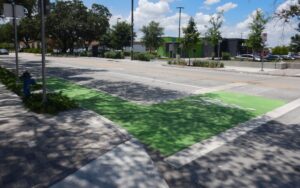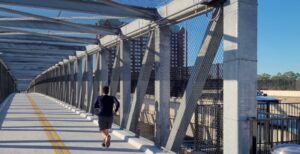
Recognizing a need to acknowledge influential transportation projects that significantly contribute to the improvement of mobility across the greater Houston region, WHA’s Regional Mobility Committee has established a means to do so. The Mobility Recognition Program provides an opportunity to acknowledge projects which contribute to the overall enhancement of transportation initiatives and the region’s well-being.
Celebrating and promoting mobility improvements serves as a catalyst for ongoing advocacy, funding, development, and execution of exemplary projects. By recognizing successful projects, decision-makers at various levels within the public and private sectors are encouraged to prioritize and continue supporting these initiatives. This recognition creates positive feedback, fostering a culture that values and prioritizes transportation projects, and promotes sustained commitment and investment in the region’s mobility infrastructure.
“There are a lot of recognition programs out there; for parks, for buildings, for development, but none focus on transportation projects at the regional level. If we want to continually advance mobility-oriented goals and objectives, we need to identify and recognize the great work being done here. It’s also an opportunity to communicate our achievements to those outside the region and remind them why they should be here.” – Jim Webb, Chair, WHA Regional Mobility Committee
WHA is an advocate and partner in the ongoing efforts to improve mobility. This role allows us to actively engage with entities responsible for planning, developing, and delivering multimodal transportation projects. The mobility recognition program thus becomes a platform for facilitating collaboration and information exchange among stakeholders involved in the mobility landscape of West Houston. This recognition program provides WHA the ability to express appreciation to the consultants, staff, officials, and key stakeholders involved in project development and delivery at all stages.
“We want to highlight projects that make it easier and safer for people to get to where they need to go so that those projects can serve as a model to influence the future of mobility in our region.” – Alan Steinberg, WHA President/CEO
 The eligibility criteria for projects encompasses a diverse range of modes and types, reflecting the understanding that advancements in the mobility system can take various forms. This inclusivity promotes innovation and allows for the acknowledgment of a wide array of projects, including surface transportation, public transportation, bicycle/pedestrian initiatives, intelligent transportation systems, mobility management solutions, and freight/regional goods mobility.
The eligibility criteria for projects encompasses a diverse range of modes and types, reflecting the understanding that advancements in the mobility system can take various forms. This inclusivity promotes innovation and allows for the acknowledgment of a wide array of projects, including surface transportation, public transportation, bicycle/pedestrian initiatives, intelligent transportation systems, mobility management solutions, and freight/regional goods mobility.
The recognition criterion focuses on key areas such as safety, connectivity and mobility, resiliency, economic development, innovation, and community impacts and integration. By evaluating projects based on these criteria, the program ensures that recognized initiatives contribute significantly to the overall well-being and progress of the West Houston region. Projects are assessed not only for their technical achievements but also for their broader societal impacts, such as improving safety, fostering economic growth, and enhancing community connectivity.
“Transportation and mobility improvements are vital to the growth and well-being of our region. I think it’s great to call attention to projects which help Houstonians get around with less big-city hassle. We need to salute the people who are responsible for these successful projects, and this program will provide them with the recognition they deserve.” – Sallie Alcorn, Houston City Council Member
The establishment of a regional mobility recognition program by WHA helps promote a culture of excellence, collaboration, and sustained commitment to transportation projects. Through acknowledgment, WHA aims to celebrate achievements, encourage ongoing support, and contribute to the continuous improvement of the West Houston region’s multimodal mobility landscape.
